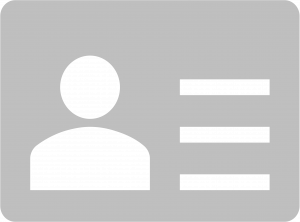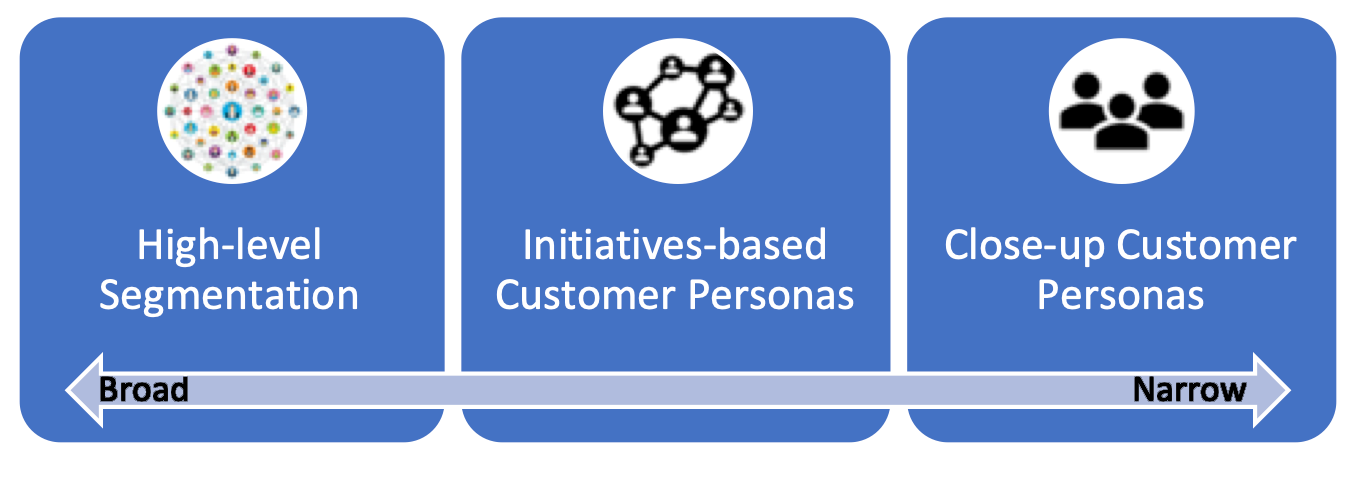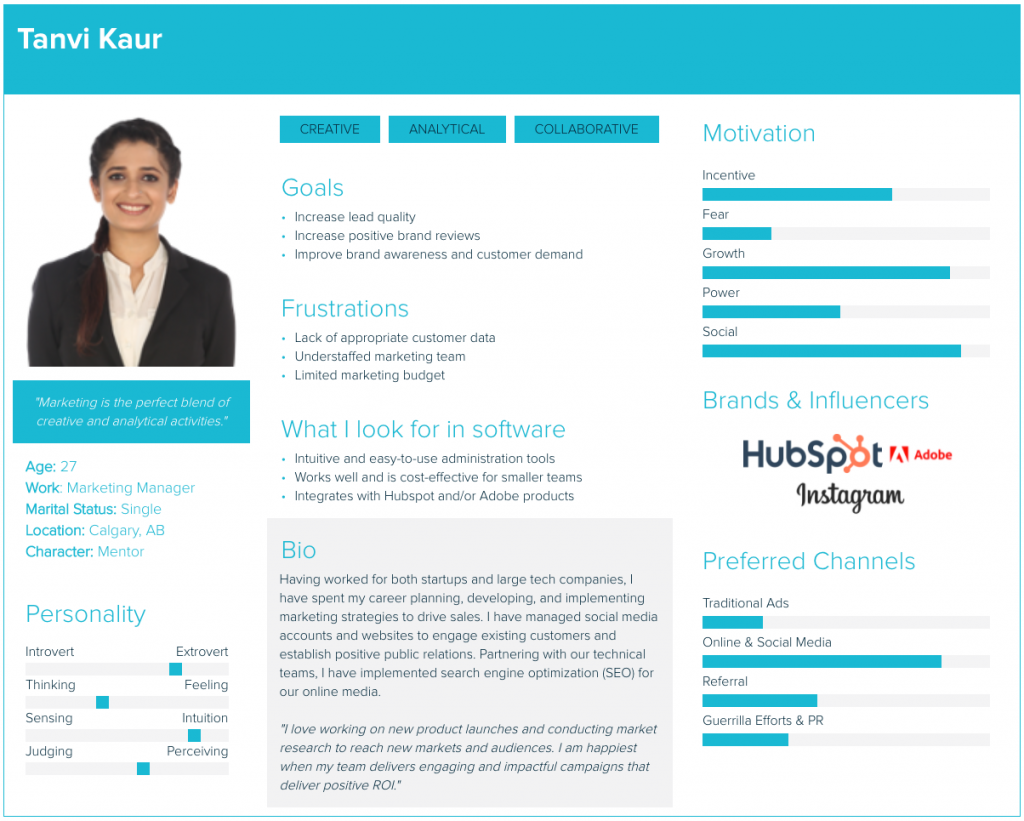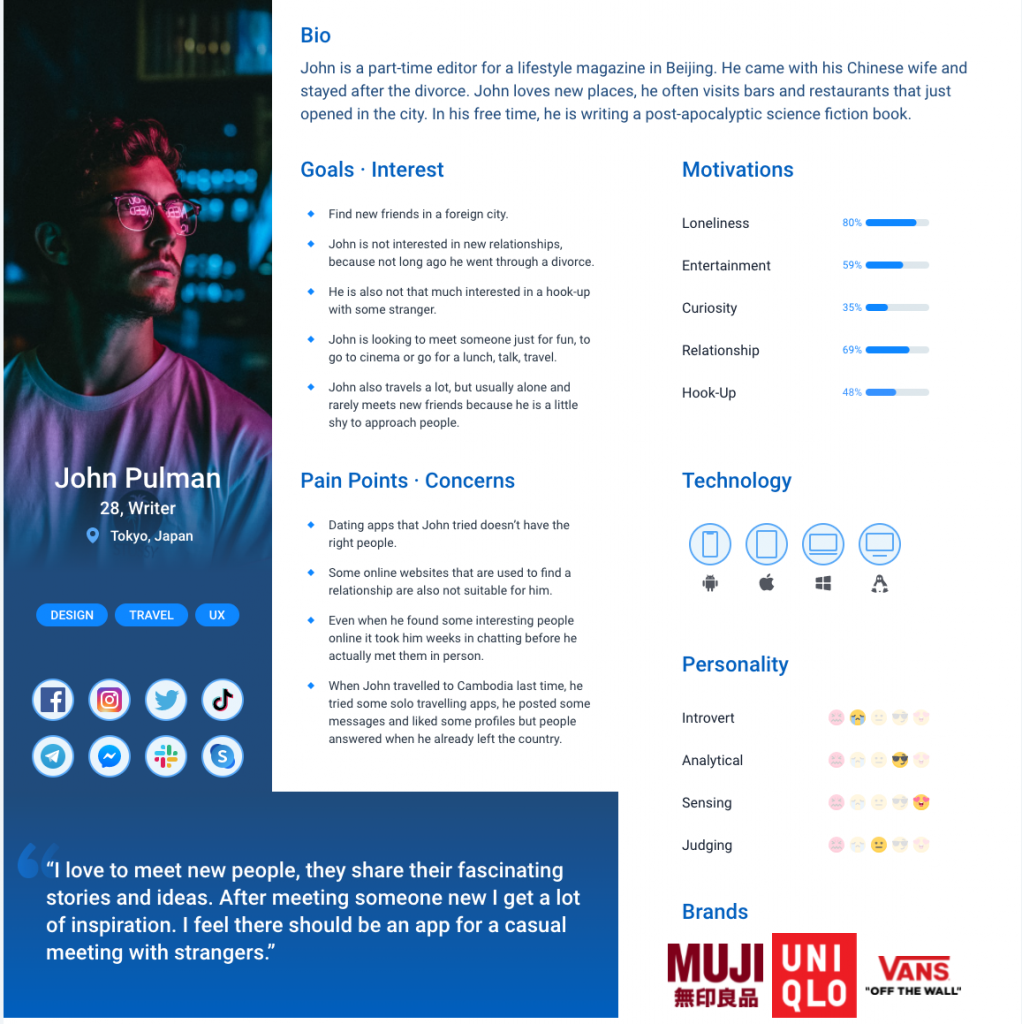Fundamentals of Digital Marketing
6 Customer Personas
Learning Objectives
By the end of this chapter, you should be able to:
- Define what a customer / buyer persona is
- Explain the key steps in developing data-driven customer personas
- Describe internal and external data sources used to develop customer personas
- Analyze a data-driven customer persona
- List the pros and cons of customer personas

What is a Customer / Buyer Persona?
As we saw in the previous chapter, most marketing strategies and activities begin by asking: Who are our “customers” or “users”? Please note that when we use the term “customer” or “user”, we are referring to your target audience. For example, “customers” or “users” could be:
- Buyers of an organization’s product or service, or
- Donors for a fundraising non-profit organization, or
- Applicants for an educational institution, or
- Constituents for a federal or municipal government.
In this chapter, we will use the terms “customers”, “users”, and “target audience” interchangeably. Please feel free to substitute any specific definition that applies to your organization.
Assuming you have defined your target audiences, the next important step in developing an understanding of your key customers and target audiences is creating “data-driven customer personas”. Simply defined, data-driven customer or buyer personas are semi-fictional representations that showcase the key traits of a segment of your target audience, based on data you have collected from customer research and/or any other analytics platforms.
Here is a 9-minute video, How To Create A User Persona, that provides a nice summary of what customer personas are, as well as walks you through the process of building your own:
If you are focused more on technical user design, user interfaces (UI), and user experience (UX), the following video, How to Create UX Personas, provides yet another important perspective:
Now that you understand what customer personas are, let’s explore a few different types of customer personas.
Types of Customer Personas
There are a few different approaches to developing your customer personas:
- Data-driven and Proto/Ad hoc/Lean Customer Personas
- Initiatives-based vs. Close-up Customer Personas
Data-Driven vs. Proto / Adhoc / Lean Customer Personas
The main difference between “data-driven” customer personas and “proto, adhoc, or lean” customer personas has to do with how the personas are created. In an ideal world, you start with a blank sheet of paper, make no assumptions, and conduct extensive audience research. You talk to lots of real-world people and use the data collected to construct personas. This is the data-driven approach, and it is how personas should – ideally – be created.
That said, many organizations do not have the time, budget, or desire to do this level of research. So, rather than stall the customer persona process or have no personas at all, you can use a different approach: proto or ad hoc customer personas. This approach is described in detail in the book Lean UX by Jeff Gothelf and Josh Seiden, and as a result, these personas are sometimes also called lean personas.[1]
Proto, adhoc, or lean personas normally are not created by doing extensive external audience research, but rather by collecting information primarily from within an organization. For example, you might hold a workshop or meeting with various stakeholders and ask them to describe your target audience. Based on everyone’s input and/or experience, you can start building some ‘rough’ personas.
The critical thing to note is that these rough personas are not research-led and therefore contain assumptions or biases that may or may not be true. While proto, adhoc, or lean personas can be useful tools, treat them with caution and verify them with research – even if that research happens well after you have created your rough personas. A good approach is to start with a few proto personas to get the process rolling and to get stakeholder buy-in. Then, over time, conduct research to verify and validate their accuracy and refine them as you gain more audience insights and gather more audience data.
High-level Segmentation vs. Initiatives-based vs. Close-up Customer Personas

Another way to approach your customer personas is by exploring how broad or narrow you want your customer personas to be. Below we present three common options along this spectrum.
- High-level segmentation provides marketers with a bird’s eye view of their target audience. Since there is limited segmentation, the data driving this type of persona is quite broad and this customer persona will represent the largest / broadest segment you may want to target. For organizations that have not created personas, this is a suggested first step. However, to ensure better targeting and maximize your marketing effect, it is recommended to further segment your target audience and create more defined and narrower customer personas as time and other resources permit.
- Initiatives-based customer personas identify groups of customers, who have a moderate to high interest in a specific initiative. These are often seen with cause-based non-profits, where the target audiences are particularly interested in a specific, cause-based initiative. These customer personas often represent a subset of the high-level segmentation target audience, but do not represent those audience segments at the lowest possible level(s).
- Close-up customer personas highlight customers, who are generally interested in a specific product, service, program, or action/activity. For example, close-up customer personas might represent “customers most likely to leave”. These customer personas tend to be narrower and as a result, represent a smaller audience segment. However, because of the narrow focus, these personas are easier to target and have more in common with other members of that audience segment.
Now that we’ve discussed several types of customer personas, let’s explore how to develop data-driven customer personas.
How to Build a Data-driven Customer Persona
Below is a framework that will cover all the foundational aspects of a customer persona. However, please keep in mind that all customer personas should incorporate multiple viewpoints, i.e., if a customer persona is being developed by a single person, with only one viewpoint in mind, for only one purpose, and/or for only one stage of your customer journey (more on this in the next chapter), your persona may not support your organization as a whole. As mentioned before, your customer persona should work for your product, marketing, sales, and customer success teams. So, try to include a variety of customer viewpoints in the following process because it will make your customer personas much stronger and applicable to the entire organization.
- Conduct Customer Research
To get a deeper understanding of your target audience, start by seeking out the answers to the following questions:
-
- Who are your customers?
- How do they behave?
- What are they interested in?
- What kind of challenges do they face?
More specifically, here are several customer research data points that you may want to collect and document:
| Category | Examples | Sources |
|---|---|---|
| Demographics/ Backstory |
Name, birthplace, family history, childhood memories, first job, location, etc. | CRM, Public records, social media analytics |
| Personal life | Marital status, family size, pets, diet and fitness habits, etc. | Public records, social media |
| Career | Industry, job title, experience level, retirement plans, etc. | CRM, LinkedIn, online forums, Google |
| Personality traits | Introvert/extrovert, right brain/left brain, optimistic/pessimistic/etc. | Social media, customer surveys, interviews, List of 14 free personality tests, online comments[2] |
| Online behaviour | Favorite social media platforms, search engines, mobile devices, etc. | Social media activities, online groups, forums, comments |
| Purchasing behaviour | Favorite online retailers, payment methods, spending habits, etc. | Google Analytics, Tag Manager, remarketing / retargeting tools, previous campaign analytics |
| Goals and challenges | Dream job, customer service experiences, regrettable purchases, etc. | CRM, customer service database, customer surveys, feedback, focus groups, online comments |
| Objections | Communication issues, product features, purchasing methods, etc. | CRM, customer support database, customer surveys, interviews, focus groups |
For some more ideas, you may also want to consider Hubspot’s list of what you should consider when defining buyer personas. [3]
- Identify Customer Pain Points
Either through customer surveys, interviews, or social listening, you will want to identify the key pain points your customers have, e.g,:
-
- What problems or hassles are they trying to solve?
- What’s holding them back from success?
- What barriers do they face in reaching their goals?
- Identify Customer Goals
This is the flip side of pain points. Pain points are problems your potential customers are trying to solve. Goals or aspirations are positive things they want to achieve. Depending on the kinds of products and services you offer, these goals might be personal or professional. Similar to above, this information can be acquired through customer surveys, interviews, or social listening.
- Understand How You Can Help
Now that you understand your customers’ pain points and goals, it’s time to create a really clear picture of how your products and services can help. Stop thinking about your brand in terms of features and dig deep to analyze the benefits you offer to customers. Consider your products and services from a customer’s point of view. And, keep in mind the following three questions:
-
- How can we help?
- What are your audience’s main purchasing barriers?
- How can you help customers overcome any barriers / pain points and achieve their goals?
- Define and Name Your Customer Personas
Define and name these customer segments. Start looking for common characteristics and patterns. As you group those characteristics together, you’ll have the basis for your unique customer personas. Take your collection of characteristics and turn them into a persona that you can identify with and speak to. Give your customer persona a name, a job title, a home, and other defining characteristics. You want your persona to seem like a real person.
Customer Persona Analysis Exercises
Let’s look at a few sample customer personas …
 Here we have Marketing Manager, Tanvi Kaur, a business-to-business (B2B) persona. We can see her goals and aspirations, and even the experience she’s seeking when looking for products and services. It’s interesting that we also have a mix of bulleted statements, as well as quotes from Tanvi herself. It’s beneficial to let your personas speak for themselves. This little touch goes a long way towards showing the individual’s personality and can also provide cues to the type of language the persona uses and what messaging might resonate with them.
Here we have Marketing Manager, Tanvi Kaur, a business-to-business (B2B) persona. We can see her goals and aspirations, and even the experience she’s seeking when looking for products and services. It’s interesting that we also have a mix of bulleted statements, as well as quotes from Tanvi herself. It’s beneficial to let your personas speak for themselves. This little touch goes a long way towards showing the individual’s personality and can also provide cues to the type of language the persona uses and what messaging might resonate with them.
Looking at Tanvi’s customer persona above, how would you answer the following questions:
- What additional details might be useful for this customer persona?
- If you were a software company, how might you target Tanvi?
Here we have John Pulman, a business-to-consumer (B2C) customer persona:
 Who knew that a writer could be so well defined? This persona provides a great example of digging deep to fully understand your customers. Not only do we get a glimpse into John’s life, background and interests, we also get to know him in terms of pain points and concerns. His influences and brand affinities are an important inclusion as well, as these can provide critical cues for messaging and interactions.
Who knew that a writer could be so well defined? This persona provides a great example of digging deep to fully understand your customers. Not only do we get a glimpse into John’s life, background and interests, we also get to know him in terms of pain points and concerns. His influences and brand affinities are an important inclusion as well, as these can provide critical cues for messaging and interactions.
Once again, here are some questions related to John:
- What other information might you include in a B2C customer persona?
- Besides dating apps, what types of companies might be interested in having John as their customer?
Pros and Cons of Customer Personas
Customer personas can be an important strategic and tactical tool. However, it is helpful to review some of the common pros and cons.
Cons
- Significant Time and Effort
To be done well (and correctly!), customer personas take time and effort. Organizations may not want to (or be able to) invest the necessary time to create truly data-driven customer personas. As a result, customer personas may be based on customer “aspirations” or customer stereotypes instead of observed behaviours or properly researched customer data; this can defeat the purpose of customer personas being objective representations of a customer group. To avoid this, consider the realities of the effort and ensure proper allocation of resources for customer research.
- Poor Research Practices
Those conducting the customer research may not have advanced research skills. Given that data-driven customer personas are based on data and the research collected, the personas may be built on faulty, inadequate, or biased data. Naturally, all of these “mistakes” will cascade through your personas. Ideally, you should hire professional researchers for this purpose and develop personas based on their extensive research data. That said, many organizations may not be willing / able to commit these kinds of resources to this task. Therefore, it is recommended to use a combination of primary and secondary research to ensure that your customer personas are not just based on data collected exclusively by your organization, but also incorporate data collected by third parties. Along these lines, cite all your sources, both internally and externally, so that if you discover any research bias, you can quickly update your data models and update your customer personas accordingly.
- Just Fictional Stories
Some argue that personas are all made up of stories and our perceptions. In the past, this statement may have been true. However, with the amount of data available to organizations today, customer personas can be based on observed data and reflect the reality of what is happening. That said, do be careful in how interpretations of the data can enter into customer personas. Try to make sure personas are based on real data. Even then, consider personas as supportive data and not the only source of customer insights. This is why customer personas require testing, validation, and updating because with an iterative approach, you can identify false assumptions or interpretations built into your personas.
- Outdated
Because changes are happening quickly, some people will argue that customer personas are outdated. Like most strategic and tactical tools today, it is critical that you do not just create customer personas and leave them. Use them to guide your organizational strategies and activities. But, also try to measure real-time data as much as possible to see if your personas match the customers you are attracting and engaging with. If not, there is a mismatch, and your customer personas need to be updated. Remember the customer persona process is circular. Customer personas are living documents.
Pros
Customer personas assist marketers in knowing what to promote, to whom, when, and through which marketing channels. With digital marketing on the rise and more and more marketing channels available to marketers, making sure you spend your time and money on the appropriate marketing channels and activities can define your organization’s success or failure.
In this article, What is a ‘Buyer Persona’ and Why is it Important?, there is a list of areas across your organization where customer personas can guide the direction of your work, for example:
- Product or Service Development
Product development can use customer personas to help guide and build product or service roadmaps.
- Marketing Strategies & Activities
Marketing can use customer personas to build effective strategies and also identify and prioritize marketing activities.
- Sales Prospecting & Sales Calls
Customer personas can help your sales team build rapport with potential customers by understanding what they want and being prepared to address their concerns.
- Customer Support
Customer support teams can use personas to better serve your customers by being trained on the problems your customers are trying to solve with your product or service.
- Designers
Designers can use user experience (UX) / user interface (UI) personas to develop and test useful and understandable visual customer experiences that support an organization’s conversion strategies and goals.
- Competitive Intelligence
Generate personas for competitors and discover trends as they happen. As a result, you may be able to uncover content, advertising, and partnership opportunities/strategies.
Please note that any tool and any type of market research can result in faulty insights. The key is to choose the proper tool and use it correctly. Bottom line: the identified issues are not inherent flaws in personas, but rather flaws in implementing personas. These flaws can be fixed by proper management, real customer data, and regular updating of personas.
Hopefully, you can see how powerful customer personas can be as a marketing and organizational tool. Knowing how to analyze and create your own customer personas can be important, especially as organizations experiment and try to connect with new target audiences. That said, do try, as much as possible, to develop your customer personas based on data and solid customer research!
Key Takeaways
Customer personas are important strategic and tactical tools that supports many of your digital marketing strategies and activities.
- Data-driven customer or buyer personas are semi-fictional representations that showcase the key traits of a segment of your target audience, based on data you have collected from customer research and/or analytics.
- To Build a Data-driven Customer Persona:
- Conduct Customer Research
- Identify Customer Pain Points
- Identify Customer Goals
- Understand How You Can Help
- Define and Name Your Customer Personas
Customer Persona Tools & Resources
Here are few online tools that you can use to easily create a visual customer persona:
- Hubspot’s Make My Persona
Hubspot’s persona generator is a step-by-step wizard that will walk you through the process of creating a useful customer persona for your organization. A nice touch is that it allows you assign photos to your personas as well as names. It is focused on professional clients and customers, or business to business (B2B) use. Expect to be asked for information regarding not only their job title and career goals, but also the tools they use at work, who they report to, and who reports to them. This won’t be necessary information for everyone who wants a buyer persona, but some will be delighted by this. Again, this requires you to use the tool with data you’ve segmented elsewhere and simply input that data. - User Forge
User Forge gives you more freedom to create your own criteria than other persona generators. If you know what’s important to your marketing efforts in terms of segmenting your audience, then this might be the one for you. Create quotes, blocks of text, and lists to help you and your colleagues narrow down your ideal customers and focus your marketing efforts. - Xtensio
This is a free tool that has an attractive and easy-to-use persona template. This is primarily about designing your customer persona, i.e., you will still need to complete your data analyses elsewhere. - Smaply
Smaply gives you the tools to visualize your entire customer experience by creating personas, stakeholder maps, and journey maps (again, we’ll discuss this more in Module 3). The combination of persona creator and stakeholder and journey maps is very useful. You can describe the steps that a customer takes before purchasing a product or using a service. And you can include the factors that influence their decisions and actions. This exploration can really help an organization get a handle on customers’ wants and needs. - Flow Mapp
Similar to Smaply, Flow Mapp allows you to create customer personas and customer journeys using the same tool. They offer a very easy-to-use, design editor with drag-and-drop content blocks, which makes creating and updating personas and customer journeys quite easy. As an extra bonus, you can also use Flow Mapp’s online collaborative tools to design your websites and apps.
Media Attributions
- How To Create A User Persona (Video Guide) by CareerFoundry is under a Standard YouTube License.
- How To Create UX Personas by UX Mastery is under a Standard YouTube License.
- High-level Segmentation vs Initiatives-based vs Close-up Customer Personas by Rochelle Grayson is licensed under a CC BY 4.0 licence.
- Tanvi Kaur B2B Customer Persona by Rochelle Grayson is licensed under a CC BY 4.0 licence.
- John Pulman customer persona by Rochelle Grayson is licensed under a CC BY 4.0 licence.

